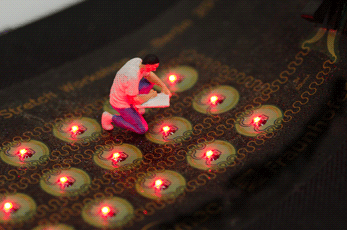Crossref Citations
This article has been cited by the following publications. This list is generated based on data provided by Crossref.
Yavuz, Abdulcabbar
2020.
Copper- and nickel-based flexible polyester electrodes for energy storage devices.
Journal of Materials Research,
Vol. 35,
Issue. 16,
p.
2115.
Veske, Paula
and
Ilén, Elina
2021.
Review of the end-of-life solutions in electronics-based smart textiles.
The Journal of The Textile Institute,
Vol. 112,
Issue. 9,
p.
1500.
Klochko, N. P.
Barbash, V. A.
Petrushenko, S. I.
Kopach, V. R.
Klepikova, K. S.
Zhadan, D. O.
Yashchenko, O. V.
Dukarov, S. V.
Sukhov, V. M.
and
Khrypunova, A. L.
2021.
Thermoelectric textile devices with thin films of nanocellulose and copper iodide.
Journal of Materials Science: Materials in Electronics,
Vol. 32,
Issue. 18,
p.
23246.
Costa, Rui S.
Soares, O. Salomé G.P.
Vilarinho, Rui
Moreira, J. Agostinho
Pereira, M. Fernando R.
Pereira, André
and
Pereira, Clara
2021.
Unveiling the role of oxidative treatments on the electrochemical performance of carbon nanotube-based cotton textile supercapacitors.
Carbon Trends,
Vol. 5,
Issue. ,
p.
100137.
Pirson, Thibault
and
Bol, David
2021.
Assessing the embodied carbon footprint of IoT edge devices with a bottom-up life-cycle approach.
Journal of Cleaner Production,
Vol. 322,
Issue. ,
p.
128966.
Ojstršek, Alenka
Jug, Laura
and
Plohl, Olivija
2022.
A Review of Electro Conductive Textiles Utilizing the Dip-Coating Technique: Their Functionality, Durability and Sustainability.
Polymers,
Vol. 14,
Issue. 21,
p.
4713.
Gallmetzer, Josef M.
Kröll, Stefanie
Werner, Daniel
Wielend, Dominik
Irimia-Vladu, Mihai
Portenkirchner, Engelbert
Sariciftci, Niyazi Serdar
and
Hofer, Thomas S.
2022.
Anthraquinone and its derivatives as sustainable materials for electrochemical applications – a joint experimental and theoretical investigation of the redox potential in solution.
Physical Chemistry Chemical Physics,
Vol. 24,
Issue. 26,
p.
16207.
Ivić, Jelena
Petritz, Andreas
Irimia, Cristian Vlad
Kahraman, Bilge
Kanbur, Yasin
Bednorz, Mateusz
Yumusak, Cigdem
Aslam, Muhammad Awais
Matković, Aleksandar
Saller, Klara
Schwarzinger, Clemens
Schühly, Wolfgang
Smeds, Annika I.
Salinas, Yolanda
Schiek, Manuela
Mayr, Felix
Xu, Chunlin
Teichert, Christian
Osiac, Mariana
Sariciftci, Niyazi Serdar
Stadlober, Barbara
and
Irimia‐Vladu, Mihai
2022.
Pinaceae Fir Resins as Natural Dielectrics for Low Voltage Operating, Hysteresis‐Free Organic Field Effect Transistors.
Advanced Sustainable Systems,
Vol. 6,
Issue. 10,
Huniade, Claude
Melling, Daniel
Vancaeyzeele, Cédric
Nguyen, Giao T.‐M.
Vidal, Frédéric
Plesse, Cédric
Jager, Edwin W. H.
Bashir, Tariq
and
Persson, Nils‐Krister
2022.
Ionofibers: Ionically Conductive Textile Fibers for Conformal i‐Textiles.
Advanced Materials Technologies,
Vol. 7,
Issue. 10,
Kılıçarslan, Boğaç
Bozyel, Ibrahim
Gökcen, Dinçer
and
Bayram, Cem
2022.
Sustainable Macromolecular Materials in Flexible Electronics.
Macromolecular Materials and Engineering,
Vol. 307,
Issue. 6,
McQuillan, Holly
and
Karana, Elvin
2023.
Conformal, Seamless, Sustainable: Multimorphic Textile-forms as a Material-Driven Design Approach for HCI.
p.
1.
Veske, Paula
Bossuyt, Frederick
Thielemans, Filip
and
Vanfleteren, Jan
2023.
Measuring the Flex Life of Conductive Yarns in Narrow Fabric.
Micromachines,
Vol. 14,
Issue. 4,
p.
781.
Casciani, Daria
and
Wang, Wei
2024.
Fashion for the Common Good.
p.
3.
Guridi, Sofía
Iannacchero, Matteo
and
Pouta, Emmi
2024.
Towards More Sustainable Interactive Textiles: A Literature Review on The Use of Biomaterials for eTextiles..
p.
1.
Hakola, Liisa
Hakola, Elina
Palola, Sarianna
Tenhunen‐Lunkka, Anna
and
Lahtinen, Jussi
2024.
Durable and sustainable smart tags for identity management and condition monitoring: Case study for reusable packaging and recyclable data carriers.
Packaging Technology and Science,
Vol. 37,
Issue. 2,
p.
107.
Pervez, Md. Nahid
Riza, Mumtahina
Talukder, Md. Eman
Hasan, K.M. Faridul
Habib, Md. Ahsan
Jahid, Md. Anwar
Stylios, George K.
Naddeo, Vincenzo
Dolez, Patricia I.
Ahmed, Firoz
Mondal, Md. Ibrahim H.
and
Cai, Yingjie
2024.
Smart Textiles from Natural Resources.
p.
343.
Stagun, Lars
Rotzler, Sigrid
Werft, Lukas
and
Von Krshiwoblozki, Malte
2024.
Towards Industrialized E-Textile Assembly: Low Temperature Optimization of Textile-Electronic NCA Bonding.
p.
91.
Mushi, Ngesa Ezekiel
Bigambo, Pendo Nandiga
and
Mondal, Md. Ibrahim H.
2024.
Smart Textiles from Natural Resources.
p.
831.
Su, Yu
Zhang, Yaling
Liao, Enze
Liu, Xiaoyan
Li, Changlin
Liu, Yu
Geng, Chengzhen
and
Lu, Ai
2024.
3D printed multifunctional hierarchical structured cellular silicones with ultraelasticity, extreme load-bearing capacity, shape morphing and sensing properties.
Composite Structures,
Vol. 337,
Issue. ,
p.
118038.
Hakola, Liisa
Smolander, Maria
Orko, Inka
Sokka, Laura
and
Välimäki, Marja
2024.
Development of a Qualitative Tool for Sustainability Assessment and Application of the Tool to Benchmark Electronic Smart Labels.
Circular Economy and Sustainability,
Vol. 4,
Issue. 1,
p.
97.



